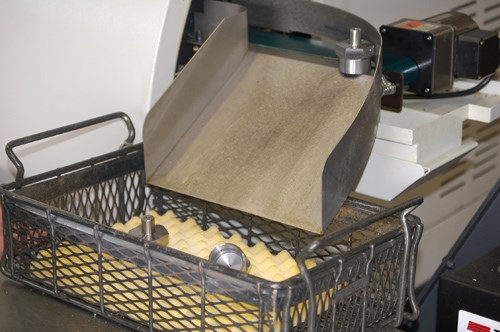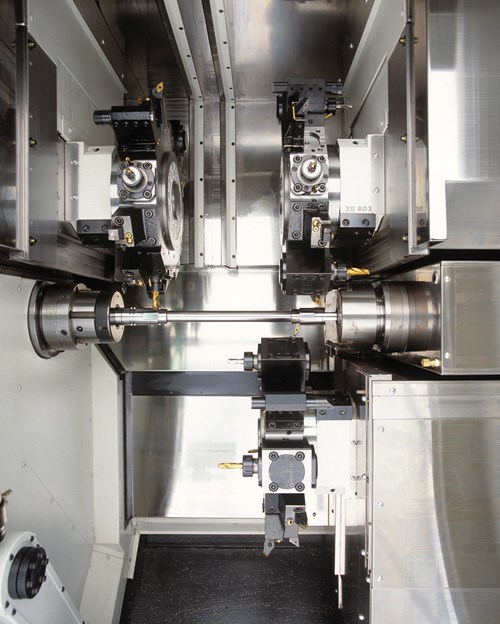Multitasking Turning Center Enables Value-Added Service
Going the extra mile for customers is something that not all shops take advantage of for one reason or another.
Going the extra mile for customers is something that not all shops take advantage of for one reason or another. But when shops choose to go this route, they are rewarded through customer loyalty, to say the least. Herker Industries (Menomomee Falls, Wis.) offers a high level of value-added service to its customers by providing sub-assembled or fully assembled parts. To follow through with the company’s value-add promise, however, it must keep up with its competition by ensuring that its machines are updated with the latest technology.
One of its eight most recent machinery purchases is the Nakamura-Tome Super NTM3 multitasking turning center from Methods Machine Tools Inc. Since the purchase of this machine, this contract job shop has increased its ability to provide custom machined components.
“By staying on the cutting edge, we’re able to provide high quality products with quicker turnaround, and we are able to pass the cost savings on to our customers,” says Dennis Driscoll, V.P. of sales at Herker. “We’re constantly striving to do things better while maintaining our strong business position.”
In the past 5 years, the 130,000 square-foot, full service machine shop has reinvested more than $5 million in technologically advanced equipment for its diverse group of customers in industries including agricultural, hydraulic, medical, automotive aftermarket and construction, to name a few.
“We don’t have a single customer or single industry that has more than 18 percent of our total business,” Mr. Driscoll says. The company’s production capabilities range from 100 pieces to quantities of 100,000,000 and offers production machining, turning, milling, threading, broaching, knurling, tapping, recessing, and more.
As one step to staying technologically advanced, the company chose the Nakamura turning center to add to its current collection of equipment.
“Engineering took a look at a vast array of parts and the jobs that we would have liked to produce faster and reduce operations on,” Mr. Driscoll explains. “This particular machine has more capabilities, more turrets, live tooling and a Y axis. We sat down and took a look at what parts we could put into a piece of equipment like the Nakamura and did time studies on them.”
Parts run on this particular turning center are engineering-intensive, made of carbon steel or alloy steel, with many features and tight tolerances that require cross drilling and cross milling, according to Mr. Driscoll.
The characteristics of the Nakamura that enticed Herker engineers to it were its three turrets, with the two upper turrets having Y-axis capabilities, as well as positions for live tools on all three turrets. According to Mr. Driscoll, whenever the company shops for a machine, it looks for improved capabilities and some form of automation.
All turrets on this multitasking machine are equip-ped with mill/drill capabilities. The machine has a maximum capacity of 72 fixed tools and 36 driven tools for milling and drilling as well as a barstock capacity range of 2 mm to 65 mm, with a 12-ft. auto loading bar feeder. These features make faster production possible by improving throughput, minimizing setup time and eliminating operations at Herker.
The benefits of the machine, after being implemented into production, were evident to the company from day one. “We are currently running seven different parts on this machine, and we have been able to increase our productivity by 50 percent, on average,” Mr. Driscoll says.
The company has eliminated as many as 2 to 3 operations as well by integrating the Nakamura into production. For example, before the new machine came along, Herker ran one part from an agricultural customer on a CNC lathe and then a machining center. But then they started running it on the Nakamura complete with about a 33 percent productivity gain, Mr. Driscoll says. Making parts complete provides not only a reduction in throughput time, but it also improves quality.
Another example of a part that went from a two-operation job to one on the new turning machine is for an electrical brake and clutch customer. This part saw a 44-percent increase in productivity, according to Mr. Driscoll.
For future applications, Herker engineers are hoping to use the Nakamura for highly technical jobs their customers order, “things that are more difficult to procure elsewhere,” Mr. Driscoll says.
Not only has the company’s newest multitasking machine eliminated operations throughout the shop, saving time and money and improving quality, but it has also allowed the company to offer its customers a high level of value-added service.
Related Content
5-Axis Machining Centers Transform Medical Swiss Shop
Traditionally a Swiss machine shop, Swiss Precision Machining Inc. discovers a five-axis machining center that has led the company to substantial growth. (Includes video.)
Read MoreShop Sets its Sights on Precise Tool Alignment
A Wisconsin shop has found that visual tool alignment technology has improved tool life and surface finishes for its Swiss-type lathes while increasing throughput as well.
Read MoreChoosing the Right Machine for Turned and Milled Medical Parts
The medical market is known for exceptionally tight tolerances and difficult materials, which means that selecting the proper machine is necessary to ensure a job is profitable.
Read MoreSoftware Controls Chip Breaking in Thread Turning Operations
This cutting tool manufacturer has developed a software module for chip control of thread turning operations in virtually any CNC lathe, even for older machines, using specific tooling and software.
Read MoreRead Next
Swiss Precision And Flexibility Help Shop Compete
This company is so pleased with its new Swiss-type turning center's performance that the company president calls it "the best possible way to keep this work in the United States." As his research indicated, the machine reduces labor costs by completing four or more machining operations in a single setup
Read MoreA Tooling Workshop Worth a Visit
Marubeni Citizen-Cincom’s tooling and accessory workshop offers a chance to learn more about ancillary devices that can boost machining efficiency and capability.
Read MoreSeeing Automated Workpiece Measurement in Real Time
User-friendly inspection software for CNC machining centers was shown at IMTS 2024 monitoring measurements between and after machining while performing SPC based on recorded measurement values.
Read More












.jpg;maxWidth=300;quality=90)

.jpg;maxWidth=300;quality=90)










